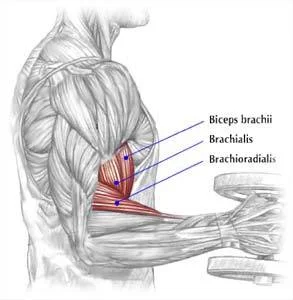It’s been a long week. Between training clients, helping some readers with calorie tracking after reading last week's post (click here), and writing an article submission for another site, I haven’t had much time for timmyhendren.com content. So, I did what every self-respecting d-bag does when time is limited in the gym, bicep curls. While you’ll frequently hear experts downplay direct arm work in favor of hitting the major muscle groups with compound movements, I’ve yet to meet anyone who wouldn’t be happy with a chiseled set of biceps and triceps during tank top season. Compound movements should certainly be higher on your priority list for strength and overall size goals, but nothing beats good ol’fashioned curls and pushdowns to add size and definition to the pipes.
When training biceps, there are 100s of curl variations and just like anything else, some are more effective than others. Typically, a supinated (palms up) grip is used to emphasize the biceps-brachii, which is the large, 2 headed muscle located at the front of the upper arm aka the muscle flexed in the bathroom mirror most frequently. While supinated curls are great, pronated curls (palms down) aren’t used nearly as much but target the brachioradialis (located in the forearm) and brachialis (located deeper in the upper arm behind the biceps brachii, responsible for elbow flexion). Targeting these muscles will improve grip strength, elbow stability, and (more importantly) badassery of the total arm.
Photo from Delavier's Strength Training Anatomy
In a perfect world, we would all have time to hit 3 or 4 different curl variations each workout. However, not many of us these days have an hour to spend pumping arms after all the major muscle groups have been adequately trained. When choosing 1 curl variation, you need maximum muscle activation to make it count if you want those sleeves to hug a little tighter. May I present to you: the Zottman Curl.
This movement combines the best of both worlds, a supine and prone grip curl, maximizing the amount of muscles activated. Start the curl with palms up and lift like a traditional dumbbell bicep curl. At the top of the movement, flex the bicep as hard as possible (think about flexing in the mirror). Before you begin your descent, flip your wrists so that your palms are facing down and use a 3-second eccentric (lowering portion of lift) until your arms are locked out. Make sure to maintain a straight wrist for the duration of the eccentric portion of the lift. Then flip your wrists so palms are up before you begin the next rep. Do 3-4 sets of 8-10 reps and enjoy one of the best arm pumps you have ever had.
Some clients have reported wrist discomfort when the palms are completely pronated, if this is the case, flip the wrists at the top of the movement as much as they can pain free and descend in that position. If the descent can be performed anywhere between pronated and neutral (palms facing each other), the lift will be just as effective. Just like with any lift, if joint discomfort is the limiting factor, you must change the exercise so that muscle fatigue is greater than joint pain.
Give it a whirl and let me know how it goes in a comment!


